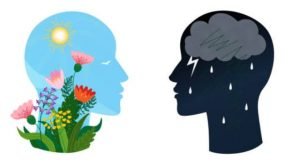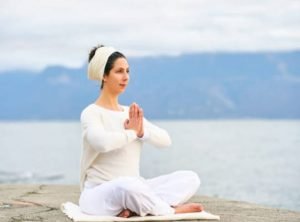
by admin | Jun 11, 2022 | Yoga
what is kundalini yoga
Awakening through Kundalini Yoga
One of the most powerful forms of yoga is Kundalini Yoga. As one of the oldest Yoga styles, it is powerful enough that it was dubbed the mother of all yoga’s. It was first mentioned in the Upanishads, an ancient Sanskrit text, that was written between 1000 and 500 B.C. Yoga of this type awakens the Muladhara Chakra, located at the base of our spine. It is believed to be associated with the divine feminine.
Kundalini takes its name from a Sanskrit word which means coiled snake. In Kundalini Sadhana (practice) it is said that the energy lying dormant at the base of the spine, coiled up and tense, becomes uncoiled and rises up the spine through the body to become in alignment with the body’s chakras. The coiled energy resembles a serpent that has three and a half coils, resting at the bottom of the spine. The three coils in Kundalini Yoga are known as the three Gunas which are the Sattva, Rajas, Tamas. The VIkritis represent the half coil.
Kundalini Yoga is also known as the symbol of equality and power for both genders. The masculine power is known to be Siva (or Shiva) and Sakti (or Shakti) for the females. They become the elemental source of power and energy when they are united. We of course all carry, as human beings, elements of both within us, it is just that one or the other may be dominating. The union of Siva and Sakti occurs in the brain which gives us the sense of feeling and affection, energy and love. This means Kundalini Yoga is good to eliminate the feeling of sorrow, depression, anger and jealousy.
Kundalini Yoga gives rewards to Yogis who maintain unity, awareness and spiritual transformation. Some say that the Kundalini produces a hissing sound when it is awakened, like the sound of a serpent as it goes from the Muladhara Chakra to the Brahma Nadi (the channels through which energy and spiritual knowledge flows) and on to the Sahasrara Chakra (Crown chakra.)
In the year 1969, Yogi Bhajan introduced Kundalini Yoga and throughout the 70’s it spread through the Western world. It includes the practices of the common Mantra, meditation, chanting, breathing and the classic poses. This type of yoga actually focuses more on chanting and breathing. It does not really concentrate on the Kundalini Yoga Poses alone.
If you are curious about Kundalini Yoga, it is good to first understand the pathway it takes. One thing you need to understand is the connection of this yogic practice with the Nervous System and the Spinal Cord. These two are the main focus of Kundalini Yoga as it targets your Spinal Cord and the Nervous System.
The Nervous System as we all know is an important control centre of our body. It is responsible for the imaginations, thoughts, intelligence and memory that we have. The Nervous System is composed of the brain, the nerves and most especially the Spinal Cord which gives us posture and stand. The Spinal Cord is made up of very delicate nerves and tissues, which is why we need to take care of it. Kundalini Yoga is said to be one of the most appropriate practices for this. The overall purpose is to promote spiritual enlightenment.
Kundalini yoga can be practised at home or through online channels, but there is nothing quite like being in the presence of a practised yogi.
There are several science-backed and anecdotal benefits of Kundalini yoga – let’s look at them below:
- Stress and anxiety relief
- Improves cognitive function
- Boosts self-perception
- Spiritual enlightenment
- Calms the nervous system and promotes wellbeing
- Helps to awaken love and feelings
- Helps to cope with rejection, anger, jealousy and self esteem.
So why not try this special form of yoga for yourself, plug back into your spiritual side, and get the kundalini rising to boost your health and happiness.

by admin | Jun 6, 2022 | Yoga
TOPIC – YOGA
Exercise for Your Whole Body: Sun Salutation (12 Steps)
It’s common knowledge that practicing yoga is beneficial for our health. Not only does it stretch and tone our muscles, but it also promotes relaxation of both the body and mind. Additionally, yoga has the ability to open up our chakras, energy centres, and our heart. Therefore, starting and finishing our day with some gentle yoga exercises can be an excellent way to improve our overall well-being.
The Sun Salutation ranks high among the most favoured yoga sequences.

Salutations to the sun (a greeting or acknowledgement to this wonder) represent one of the all-around yoga exercises. It works the whole body, for an overall stretch. To soothe stiffness and to wake up your body in the morning, do it once or twice as a minimum daily. You can of course repeat more times than that and I sometimes find about six rounds really wakes up both my body and mind and yet also leaves a very calming after effect and I am ready to greet the day.
At night, repeating the exercises multiple times will help you relax and it certainly helps me to drift off. Insomniacs or those with other sleep disorders often find that six to twelve repetitions are enough to get to sleep more easily. Why not give it a go.
Below is a step by step guide to the Sun Salutation.
- Place your palms together and thumbs against your chest while standing with your feet slightly apart.
- While inhaling deeply, raise your hands over your head, gently bend backwards as far as you can- don’t overdo it- and tighten your buttocks. Hold for three seconds.
- While keeping your knees straight, exhale slowly and slowly bend toward the floor until your fingertips touch the floor outside of your feet. In case you can’t touch the floor, get as close as you can.) Tuck your head in toward your knees.
- Inhale steadily and slowly, bend your knees, and place your fingertips outside your toes on the floor (if they are not already there). As far as you are able, slide your right foot back, while your right knee is elevated an inch or two (a lunge position). Lift your head as high as possible and gently arch your back.
- Before exhaling again, now slide your left foot back until it is beside the right one, and with your weight supported on your palms and toes, straighten both legs so that your body forms a flat plane. Your stomach should be drawn in toward the spine.
- Slowly exhale, bend both knees to the floor, bend with your hips in the air, lower your chest and forehead to the floor.
- Taking a deep breath inhalation, look up and bend your head back gently, raising it, followed by your upper chest, and then your lower chest. From the navel down, your lower body should be on the floor, and your elbows should be slightly bent. Maintain this position for three to five seconds.
- Exhaling slowly, lift your hips to the point where your feet are flat on the floor, your arms must be straight, and your legs should be straight. You will now be in an inverted V shape.
- Taking a deep breath, step forward with your right foot as in position 4. Let your foot rest flat on the ground between your fingertips. Your left leg should be almost straight behind you, with the knee slightly elevated off the ground. Raise your head, look up, and arch your back.
- As you exhale, place your left foot next to your right one. Straighten your legs and trying to keep your fingertips on the floor, try to touch your head to your knees as in position 3.
- Slowly inhale, curl the body back up, raise your arms up and stretch back as in position 2. Don’t forget to tighten your buttocks. Hold for three seconds.
- Slowly exhale, lowering your arms to your sides. Relax. Repeat the series.
I hope you enjoyed the practice and that you will make it part of your daily routine. If you struggled a little, it will get easier and easier as you go, I promise, you will be getting more flexible and more confident, just keep going with it and it will not be long before you are bending like a pretzel, true yoga style.

by admin | Jan 7, 2022 | Yoga
what is aromatherapy | aromatherapy benefits
Aromatherapy Is a Unique Form of Massage Therapy
Aromatherapy is a unique form of massage therapy because of the oils that are used during a session. The therapist may use one from more than 90 oils to provide psychological and physical benefits to the body.
Most of the oils used for aromatherapy come from natural ingredients. Examples of these include herbs, powders, hydrosols, sea salts, sugars, clays and mud. In professional therapeutic circles It may be frowned upon when some use synthetic ingredients.

It is widely practiced in the US and in Europe and integrated into holistic treatments. Aside from oils, aromatherapy can be using candles, diffusers and bath salts which allow you to enjoy it in the comforts of your home.
Aromatherapy is used to treat various health conditions. These include allergies, bruises, burns, diarrhoea, bronchitis, colds, earache, energy depletion, flu, headaches, insomnia, menopause, nervousness, scars, sprains, stress, shingles and wounds, to name a few.

For home treatment, you can buy these oils off the shelf and then use them whenever you feel like it. These are easy to spot as they are all packaged in small bottles with the name of the oil and the ingredients that are used. If you are not familiar with the oil, you can open it and smell it to see if it is worth buying. They deal with a whole host of issues.
For a troublesome head cold for example, once you have these amazing oils, you only have to add 2 to 3 drops like eucalyptus, tea tree or rosemary in hot water. You then hold your head over the bowl and then inhale the aroma. Watch your head cold clear in a very short time. For other problems, you can apply oils to baths and compresses.

Aromatherapy per se is not designed to treat any major illness. It is said to only relieve minor problems so before you try aromatherapy, it is best to first consult with a doctor.
However, many people with chronic ills by the efficacy.
If you decide to go for a massage, talk with the practitioner about your medical history and current physical condition. Knowing how you feel is the only way for him or her to determine what oil should be used for the session.
Women who are pregnant or nursing should not undergo aromatherapy without consulting a fully qualified aromatherapist who can advise, as the scents from the oils or the oils themselves, could be harmful to the mother and / or infant. Caution is advised.
For those who want to know more about aromatherapy, they can read it in the amazing books or in blogs on the Internet. There are also classes that cater for people of all levels, so anyone can join, so they can learn how to mix the oils together.
The benefits of aromatherapy as mentioned earlier are psychological and physical because the scent simulates the brain to trigger a reaction and at the same time supply therapeutic relief. A good example is eucalyptus oil which is known to ease congestion.
When the oil is applied to the skin, it is absorbed by the bloodstream and aids in certain other health, beauty and hygiene conditions. It is also uplifting and creates a feeling of energised positivity.
If you want to learn more about aromatherapy, you can also take up classes. Here you will learn how to mix the oils together and create your own concoctions. Most programs will cost a little, plus the materials to be used during the sessions.
Aromatherapy is a unique form of massage therapy because you don’t need physical contact all the time to get relief. You can inhale it or bathe in it. It is truly, a holistic form of healthcare that is worth checking out.
However, as we are focused this month on massage, one has to say that there is nothing quite as healing as the touch of a professional aromatherapist. So, if you are feeling low, do go and get an aromatherapy massage to enhance mind body and spirit.

by admin | Jan 7, 2022 | Mind, Yoga
The Cortisol Problem | low cortisol symptoms | Part 2 – Dealing With Stress
When it comes to coping with stress from everyday life, there are several options.
For example, some people adore de-stressing by utilizing the amazing benefits of physical exercise.
Others share their concerns/stress factors with a close friend or family member and gain a sense of moral support, which reduces stress levels.
There’s also a third group of people who, no matter what they do, can’t seem to get rid of their chronic stress.
Now, different things work for different people, so in this second article of the series, we’ll shed some light on the most viable stress-relieving methods.
Without further ado, let’s get to it!
#1 Physical Exercise

Engaging in physical activity is one of the best ways to deal with stress for a number of reasons.
Doing exercise will stimulate the body to secrete and release a flurry of nurturing substances and compounds, which will inevitably make you feel better.
Furthermore, due to the fact that there is a recovery period after your training bout, it is much easier for the body to get out of the stress response mode and kick into recovery mode – It has all the reasons to do so!
Generally, prolonged cardio workouts appear to elevate the stress hormone (cortisol) levels, unlike intense, resistance training.
That is to say that if you want physical exercise to help you eliminate stress, you are best off focusing on high-intensity, short power burst exercising, like weightlifting, sprinting, calisthenics, etc.
#2 Food, food, food!

More often than not, the lack of food is a common reason for being stressed or hangry (hungry and angry!).
Without a doubt, not having enough food in your system can make you flip your switch easily.
And so, if you’re feeling stressed out but cannot find a particular reason why that is so, just unwind and have a big, satiating meal.
For this purpose, you are best off eating nutrient-dense foods, such as meat, dairy, eggs, organs, vegetables, fruits, root crops and grains.
In doing this, you will kick into the so-called “rest and digest mode”, where the body prioritizes digestion, absorption and in turn, recovery.
And as you may or may not know – All of those are down regulated when you are stressed out!
#3 Swipe Left
When a stressful condition manifests in our conscious experience, it is a natural response for us to start thinking (and eventually overthinking) about it.
The first thought of this stressor is generated by the brain, and then, some moments later, another similar thought is generated.
Then another, then another and another.
All of these thoughts combined create a story that your brain starts believing and eventually, manifests in your reality.
Usually, that story is the worst case scenario possible – This is because your brain is bracing for the worst, so that you can cope with the situation no matter what it is.
And though that is good, it generally brings a lot of stress, which slowly but surely drains you.
Now, these things are automatic but they are not really beyond your control.
When a stressful thought pops up, you can either latch onto it and follow the similar thought-creating pattern, or, you can stay emotionally neutral and choose what to do with that thought.
Whenever you have a stressful thought, be it about your ex, your job or your family, try to just mentally swipe it left and throw it in the bin.
In doing so, you will eliminate any fear, doubt and insecurity, which will in turn open up space for more constructive, positive thoughts.
This type of internal regulation is perhaps the best method to deal with stress, as it goes directly to the root cause of stress – Your perception of it.
Conclusion
In the past, the stress response was something vital, as it helped us run or fight anything that threatens our lives in the wild environment.
Nowadays however, we live in big, modern cities where death by predation is highly unlikely.
The same stress response gets triggered by harmless things like our work place, school or family.
Unfortunately, the stress response is automatic and more often than not, it takes over.
However, there are things you can do to buffer and deal with it.
In terms of self-care, the best you can do for stress management, is to regularly engage in physical activity, eat good food and sleep well.
These things however will just push your biochemistry to a more balanced stress.
The real solution for stress can be found on the conscious level, where you can observe and regulate your PERCEPTION & RESPONSE to stress.
This is where the magic happens.

















